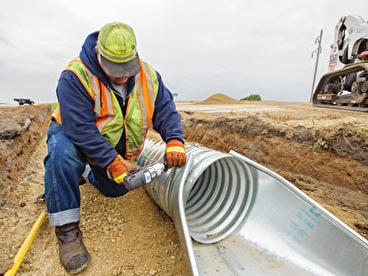Top Quality Road Construction for Long-Lasting Roads
Top Quality Road Construction for Long-Lasting Roads
Blog Article
Culvert Installment Made Easy: Step-by-Step Overview for Success
Setting up culverts might feel like a straightforward job, but making certain an effective end result requires mindful preparation and implementation. From picking the appropriate culvert size to incorporating proper water drainage measures, each action in the installment process plays an essential function in the functionality and longevity of the culvert system. By adhering to a methodical technique and taking note of essential details, the installment can continue efficiently, decreasing prospective concerns down the line. Keep tuned to reveal the crucial actions and considerations that can make culvert installment a seamless and effective endeavor.
Picking the Right Culvert Dimension
Picking the proper culvert size is critical for making certain reliable water flow and structural honesty in culvert installation jobs - Pad Construction. The size of the culvert straight affects the circulation ability of water with the framework. A culvert that is also little can bring about flooding and overflow, while one that is as well large might result in lowered water velocity, possibly creating sediment buildup and obstructions
To determine the ideal culvert size, variables such as the watershed location, peak flow rates, and hydraulic effectiveness demand to be meticulously considered. Estimations based upon these specifications help in selecting a dimension that can sufficiently take care of the anticipated water quantity while decreasing the threat of clogs and architectural failure.
It is vital to consult design guidelines and criteria to make sure that the selected culvert size fulfills the task requirements and local policies (Pad Construction). By selecting the ideal culvert dimension, task supervisors can maximize water circulation, prevent possible problems, and boost the overall performance and durability of the culvert installation
Preparing the Setup Site
Reliable culvert installation demands thorough preparation of the installation site to make certain optimal structural support and functionality. Prior to beginning the installation process, it is essential to clear the site of any type of debris, greenery, or blockages that could hinder the culvert's positioning.
Additionally, it is essential to take into consideration elements such as soil structure, groundwater levels, and ecological influences when preparing the installation site. Carrying out a detailed website evaluation can help recognize any possible difficulties or threats that might affect the culvert's performance. By taking the time to prepare the installment website properly, you can assist guarantee a successful culvert installation that satisfies architectural requirements and makes sure lasting capability.
Placing the Culvert Appropriately

The quality at which the culvert is placed is vital for preserving an appropriate incline for water flow. my explanation A gradual incline aids stop merging and advertises efficient drainage. Additionally, the culvert must be oriented appropriately to make sure that the inlet and electrical outlet remain in the proper places. This alignment is necessary for the culvert to operate efficiently in handling water flow.
Backfilling and Condensing the Dirt
Proper backfilling and compaction of the soil around the culvert is important to guarantee security and prevent potential issues in the future. Once the culvert is appropriately placed, the following crucial action is to backfill the area around it with suitable product. The backfill material should be without rocks, debris, and organic matter to prevent damage to the culvert. It is suggested to utilize granular material such as sand or gravel for backfilling, as it supplies excellent drainage and compaction properties.
After positioning the backfill product, it is crucial to compact it in layers of consistent thickness. Using a compactor or a mechanical tamper, compact the soil carefully to prevent damaging the culvert. Compaction aids in decreasing the possibilities of negotiation and guarantees consistent assistance around the culvert. It is essential to compact the soil evenly on all sides of the culvert to preserve its architectural stability.
Correct backfilling and compaction not only give stability to the culvert yet also assist in preventing dirt disintegration and maintaining the longevity of the culvert system.
Making Sure Proper Drainage Combination
Incorporating efficient drain remedies plays a crucial role in the general performance and durability of culvert setups. Proper drainage integration is crucial for taking care of water flow, preventing erosion, and ensuring the structural integrity of the culvert system. To attain this, it is essential to create an extensive drain strategy that considers aspects such as the volume of water anticipated, the topography of the area, and the sort of soil existing.

Additionally, incorporating functions like erosion control actions, such as riprap or greenery, can better improve the effectiveness of the water click this drainage system. By carefully planning and applying these drainage options, culvert setups can operate efficiently and hold up against the examination of time.
Verdict
Finally, proper culvert setup is vital for keeping efficient drain systems. By selecting the appropriate culvert size, preparing the setup site, placing the culvert appropriately, backfilling and condensing the dirt, and ensuring correct drainage integration, success can be attained. Following these actions will certainly assist make certain the durability and effectiveness of the culvert, eventually contributing to the overall success of the water drainage system.
Report this page